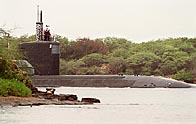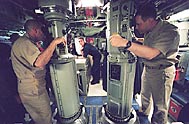Posted on: Sunday, March 4, 2001
Submarines using war procedures can pose peacetime risk
By Eugene J. Carroll
and James Bush
The U.S. "Silent Service" is understandably committed to perfecting the ability of American submarines to roam the seas undetected by adversaries.
 |
| The fast-attack submarine Greeneville at Pearl Harbor: It’s the submarine’s responsibility to avoid collisions when it surfaces, but Cold War thinking may have limited its safety options.
Advertiser library photo • Feb. 10, 2001 |
During the 40-year course of the Cold War, American and Soviet submarines operated under near-wartime conditions, each seeking to detect and trail the other without revealing their own presence. No other military service came close to operating at the tense level of confrontation with its Soviet counterpart as did U.S. submarines in this game of cat and mouse.
Could this historic pattern be part of an explanation for the tragedy nine miles off Honolulu on Feb. 9? The reason to ask this question goes to the heart of the challenge a Navy court of inquiry will face in its forthcoming investigation: Why was the USS Greeneville unable to detect the presence of the Ehime Maru before beginning its fateful ascent?
Under maritime law, a submarine has the sole and absolute responsibility to avoid collision with any and all other craft when it surfaces. The reason for this is obvious: Civilian surface craft have no means of detecting a submerged submarine, whereas submarines have multiple sensors that can guide them safely to open areas free of surface contacts.
The Navy court’s primary inquiry will focus on how effectively the Greeneville used these sensors before commencing a training exercise — an emergency ballast blow that brought it to the surface as a destructive force, threatening the safety of any object in its path. From information released to date, it appears the court will find that the Greeneville used only two of its sensors to make sure the surface was clear of all ships before ascent.
These two sensors were its passive sonar and its periscopes. Passive sonar consists of acutely sensitive listening devices that enable operators to detect and analyze any sounds generated by surface ships (and other submarines). These sounds are created primarily by the rotation of screws propelling the craft but also by the sound of machinery within it. The periscopes provide visual coverage of the surrounding area while the submarine lurks about 60 feet (keel depth) below the surface.
 |
| Cmdr. Mark Ginda, commanding officer of the USS Pasadena, left, and Lt. j.g. Brandon Christensen must do several 360-degree scans to ensure there are no surface ships above them when they surface.
Advertiser library photo • Nov. 6, 1999 |
By contrast, there has been no reference to the Greeneville using its two other sensors — active sonar and radar, both of which are capable of locating even the quietest of surface contacts that the first two might miss. Here is where the practices of the Cold War may have come into play. Both active sonar and radar are like beacons that could reveal the presence of the Greeneville to an adversary. This could be fatal in wartime. It may well be that the court will find that U.S. subs still normally follow wartime procedures and avoid overt use of the sensors that might reveal their presence to a potential adversary.
Understandable as this may be in wartime, the Greeneville was operating not only in peacetime conditions without any adversary but also in an area heavily used by commercial and recreational shipping. The absolute legal requirement to ensure surfacing clear of all other traffic demanded the use of every available sensor.
Many media reports have focused unduly on the presence of civilians aboard the Greeneville who might have distracted the crew from the proper performance of their duties. In our personal experiences with civilian guests during training operations, this possibility has been greatly overblown. Welcome guests blend very easily into ships’ routines and can take part as interested spectators and active participants in various activities.
If anything, our experiences suggest that crew members and officers are especially attentive to their duties in order to impress the guests with their professional skills and precise execution of demanding tasks.
If the Greeneville’s captain, Scott Waddle, observed any interference or confusion caused by his guests, he had the responsibility and authority, plus ample opportunity, to order the control area cleared of civilians before initiating an emergency ballast blow.
The court of inquiry will carefully examine this factor to determine if the captain maintained orderly conditions in the control area at all times in order to ensure safe operations. It will also closely examine the Greeneville’s training records to determine if the captain had routinely maintained the highest standards of personnel performance consistent with the same high standards traditionally enforced throughout the submarine service during the Cold War.
If the court does find indications of confusion before the ascent, it should be considered evidence of a failure of the commanding officer, not an indictment of a valuable program used by all of the armed services to demonstrate U.S. military capabilities to American citizens.
Among the responsibilities of the court of inquiry is a requirement to submit relevant recommendations to higher authority on how such tragedies may be prevented in the future. If, in fact, it finds that all of the Greeneville’s sensors were not employed effectively because of wartime considerations, it is hoped the court will strongly recommend that practical, prudent safety precautions be given priority in all peacetime training operations.
Carroll is a retired rear admiral who once commanded an aircraft carrier; Bush, a retired captain, served 10 years in nuclear submarines and commanded one.
[back to top] |


